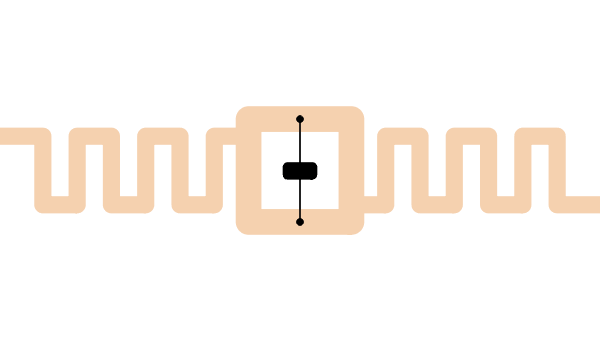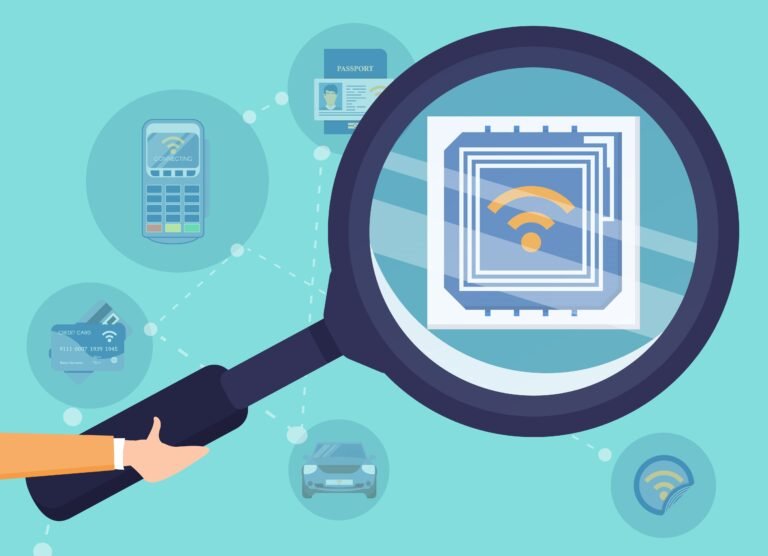Radio frequency identification (RFID) and near field communication (NFC) are two technologies that enable the exchange of data using radio waves.
NFC systems are primarily utilized in contactless payment transactions, including mobile payments and virtual wallets. RFID systems are most commonly used in retail settings, where companies can use them to track inventory in real time.
In this article, we will discuss the key differences between NFC and RFID, and the certification of NFC and RFID system.

What is RFID?
RFID stands for radio frequency identification. RFID is a wireless technology that uses radio waves to uniquely identify objects. It has been around since the 1940s, and its main purpose is to automate identification processes in various applications. RFID systems consist of RFID readers and RFID tags.
RFID Readers
RFID reader captures the radio frequency signals emitted by an RFID tag. This reader is connected to a computer system or other computing device that runs applications that process the data received from the RFID tags. The readers can be handheld, stationary, integrated into other equipment.
RFID Tags
RFID tags are attached to an object and transmit its unique identifier to an RFID reader. The reader then captures this identifier and stores it in its memory along with other information about the object it is tagging.
A radio signal, or interrogating signal, is sent by the reader in order to communicate with the tag and capture various data stored within. The radio signal operates using a specific frequency that is unique to the reader and tag combination; this ensures only those two devices can communicate with each other. The signal consists of a set of encoded information including the reader’s identity, the tag’s identity (if known), and the command that is to be executed. When the tag receives the signal, it responds with information stored within its memory. This can include data such as location or product details which are then passed back to the reader for processing.
Radio Frequency Identification (RFID) devices are a type of technology that utilize radio waves to read and collect identification data from tags, usually embedded in items. These RFID tags do not need to be inside the line of sight of the reader for them to be read, as the radio waves can pass through objects like clothing, walls, or even liquid. This makes RFID technology an extremely useful tool for asset tracking and locating objects, as well as for automating processes such as inventory management.

What is NFC?
NFC stands for Near Field Communication, a short-range wireless communication technology that enables devices to communicate and exchange data with one another. It evolved from radio frequency identification but is much more advanced, even being referred to as a ‘fine-tuned, special purpose subset’ of RFID. RFID devices are radio transmitters that use electromagnetic fields to automatically identify and track tags attached to objects. NFC device is magnetic transmitters that allow for wireless communication between two compatible devices. This type of communication is typically used for contactless payments.
An NFC system typically consists of three main functional elements: an initiator (or NFC readers), a target (such as a NFC tag, key fob, sticker, or card), and embedded NFC software.
Initiator
The initiator, also known as the reader device, is responsible for establishing communication with the target and initiating the interactions between them. A typical NFC reader device is a NFC enabled smartphone, tablet, or smart watch. However, there are also standalone readers such as those used in shops for contactless payments.
Target
The target is the NFC-enabled object that contains data stored on an embedded chip. It can be anything from a tag to a key fob to a sticker or card. These targets can be read, written to, and interacted with by a reader device or another NFC-enabled target. NFC tags are relatively more expensive than most RFID tags due to the additional cost of encoding and encrypting the data on them. In order for the NFC tags’ data to remain secure, a chip inside the NFC tags must be equipped with an encryption algorithm that is able to provide a high level of security.
NFC softwar
The software is the third component of an NFC system. This embedded software manages communication between the initiator and Target, as well as encrypting data being sent and received. It also ensures that only authorized transactions take place. This software must be compatible with the specific reader device being used, and is typically provided by the manufacturer.
Just like high frequency RFID readers, Near Field Communication (NFC) systems’ form of communication operates at a same frequency of 13.56 MHz. Near Field Communication (NFC) is a form of wireless communication technology that utilizes an alternating magnetic field to initiate communication between two devices.
RFID vs. NFC: The Difference Between NFC and RFID systems

Read Range
The read range of a reader is determined by several factors, including the frequency band that the device uses and the amount of power supplied to the transceiver. Generally, higher frequencies are associated with shorter read ranges, while lower frequencies offer longer ranges.
The read range of most RFID devices is limited to a maximum of 3-5 meters. This is due to the limitations of the frequency bands that RFID transceivers use. Higher frequencies are associated with shorter read ranges, as the signal does not travel as far or penetrate obstacles as well as lower frequencies.
Near Field Communication systems are a subset of RFID technology and are designed for short-range communication between compatible devices. The read range of NFC does not exceed a few centimeters, making it necessary for the reader to be within a direct line of sight of the tag or device being read in order to successfully receive data.
Unidirectional and Two-way Communication
RFID technology provides only unidirectional communication, meaning that data is sent from the tag to the reader, but not vice-versa. In this type of communication, the RFID tags (whether active tags or passive tags) acts as a mere transmitter of data and does not receive any response from the reader.
NFC devices offer a unique capability that can be compared to both RFID systems and other wireless communication technologies. NFC device is capable of two-way communication (it requires two active NFC devices), allowing both the reader and the tag to send and receive data, meaning it can act as both a reader and a tag.This allows for a more interactive experience between the two devices, as the reader can send a command to the tag and receive an appropriate response.
Data Transfer Speed and Volume
NFC is a technology that enables short-range communication between two devices. It has the unique capability of allowing for bi-directional communication, where both the reader and tag can send and receive data. However, NFC does have some limitations when it comes to data transfer speed and volume. The maximum transfer speed of NFC is 424 kbit/s and the maximum data volume is limited to 32 bytes of information.
The speed at which RFID readers can process data is much faster than NFC technology, with some systems capable of transferring up to 848 kbit/s. RFID readers have the capability to scan tags in batches, allowing them to process multiple tags in a short period of time. This allows businesses to quickly and efficiently read data from multiple tags at once, making it easier to track items with RFID technology.
Data Types
RFID tags are limited to simple ID data. This is because the memory capacity of RFID tags is relatively low (generally no more than 2 kilobytes) due to their size and cost. As a result, the amount of data that can be stored on an RFID tag is limited, making it difficult to store complex information.
NFC tags offer a unique advantage when compared to RFID tags, in that they can store and transfer more data. NFC tags are capable of holding multiple data types beyond simple identification, such as binary information, URLs, and even text files.
Frequency
RFID technology can operate in three distinct frequency bands, allowing businesses to select the optimal range for their particular application:
Low Frequency (LF) radio frequencies
Low Frequency (LF) radio frequencies, ranging from 125-134 kHz, are ideal for applications that require shorter read ranges. The LF band offers a maximum read range of up to 10 cm, making it perfect for identification and short-range communication purposes.
High Frequency (HF) radio frequencies
High Frequency (HF) radio frequencies, ranging from 13.56 MHz, offer a longer read range than Low Frequency (LF) radio frequencies, with a maximum read range of up to 30 cm. This makes HF RFID ideal for applications that require a longer read range than LF and is commonly used in access control systems and contactless payment systems.
Ultra High Frequency (UHF) radio frequencies
Ultra High Frequency (UHF) radio frequencies, ranging from 860-920 MHz, offer the greatest read range of all RFID technologies. The maximum read range is up to 10 meters, making UHF technology suitable for long-range identification purposes. UHF systems are commonly used in asset tracking and inventory management applications.
NFC is a subset of RFID technology that operates within the High Frequency (HF) range of the RFID frequency spectrum.
Certification of NFC and RFID Systems
In order to ensure the safety and reliability of RFID and NFC systems, they must abide by a number of standards and regulations. This is especially important since many NFC and RFID devices are used to access sensitive data, such as private financial information from credit cards or personal identification details like passports.
Companies that develop RFID and NFC based devices must comply with certain certification procedures in order to launch their products on the market. In particular, those developing such items for the US market must obtain Federal Communications Commission (FCC) certification, while those targeting European consumers must certify with the Conformité Européenne (CE) mark.
RFID and NFC devices are comprised of a range of radio-based components that enable communication between two electronic devices. Therefore, such systems are regulated by the FCC part 15. This certification process is designed to ensure that these devices do not cause interference or disruption with other wireless systems. For example, the FCC requires that emissions from these systems adhere to certain standards and radiation levels. Additionally, frequency range and bandwidth restrictions are also enforced. Notably, UHF RFID and NFC systems are regulated under a different set of standards than other wireless technologies, such as Bluetooth or Wi-Fi.
In the European Union, such systems are required to comply with CE RED certification requirements. This certification process is designed to verify that the devices meet essential health and safety requirements. Under this testing, the devices must pass a number of tests for conformity, including but not limited to electromagnetic compatibility (EMC) testing, radio frequency (RF) performance testing, and environmental testing.
NFC devices are capable of securely transmitting data over short-range radio frequencies. In addition to the FCC and CE RED regulations, NFC-enabled devices can also be NFC-Forum-certified. This certification is designed to ensure that NFC products adhere to a set of standards for secure interoperability defined by the NFC Forum.
Conclusion
RFID and NFC systems are increasingly popular technologies that use short-range communication to quickly and easily read the ID information contained on tags, labels, or cards. RFID is used in a variety of contexts, for businesses that need assistance with inventory tracking and access management, RFID is most likely the way to go. NFC technology is used for contactless payments, access control, and other applications. Both technologies are beneficial to businesses in providing reliable identification and transaction processing without the need for manual intervention. The key difference between RFID and NFC technology lies in their transmission frequencies; RFID uses higher frequencies than NFC, allowing it to read data from further away.
By offering contactless payments and the ability to store data in one central place, RFID to NFC can be used in many different applications. It is reliable, secure, and efficient and can make life easier for both businesses and consumers.





